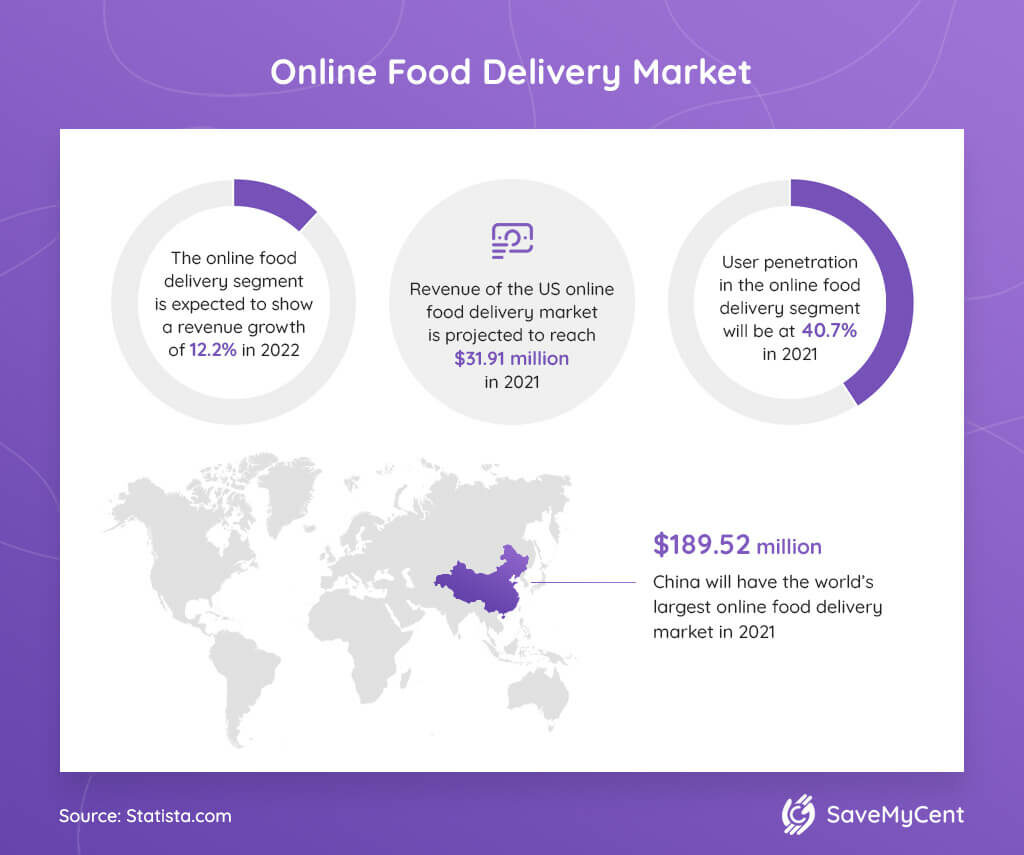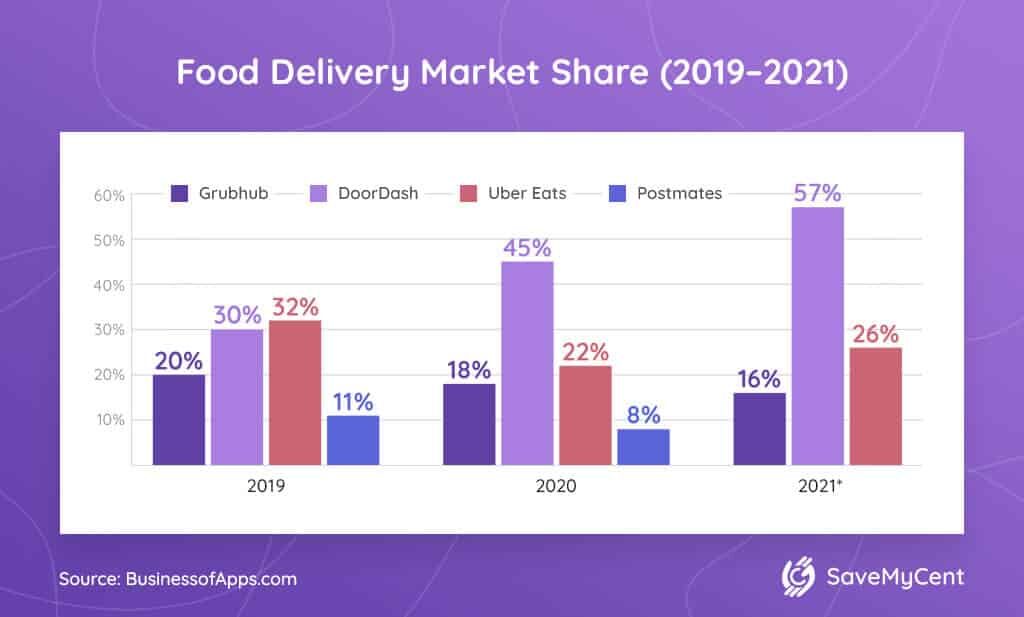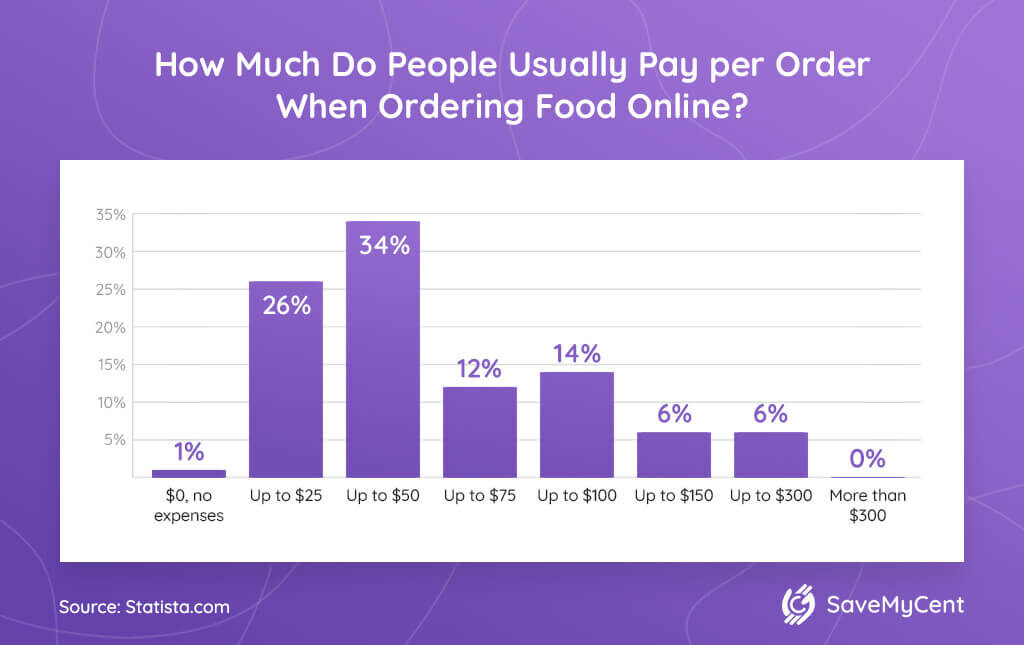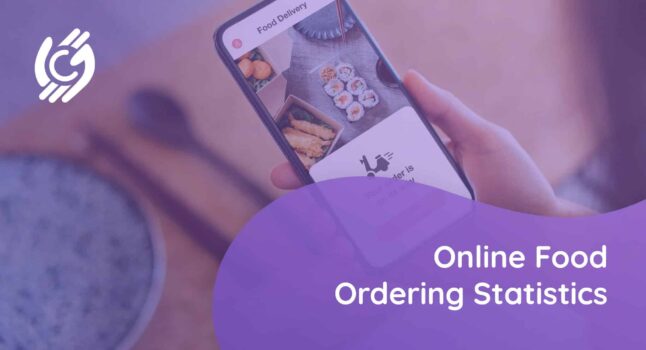Do you even remember what it was like to call your go-to pizza place on the phone and order your favorite pizza? For most of us, those days are long gone.
Digital platforms have completely revolutionized the way we eat at home. Their websites and apps now even allow us to track our food step-by-step as it moves closer to our door.
The online food ordering statistics you’ll read will help you understand how big this industry has become in recent years. You’ll also learn what the future of food delivery might look like.
So let’s sit back and dig into the most interesting food ordering facts in 2020.
Highlights of Online Food Ordering Statistics (Editor’s Choice)
- Food delivery in the US will generate $31.91 million by the end of 2021.
- China will generate $189.52 million in 2021 — more than any other online food delivery market.
- 99% of the online food ordering market is held by only three huge companies.
- 34% of consumers will, on average, spend between $25 and $50 on a single food order, according to online food ordering stats.
- 70% of customers who order online prefer ordering directly from a restaurant without giving a share of the price to a third-party platform.
- Food works like social glue as 28% of consumers order it while spending time with friends.
- People aged between 25 and 34 are the most frequent consumers when it comes to online ordering.
The Most Important Online Food Delivery Statistics in 2024
2020 was a big year for online food delivery. Due to the COVID-19 pandemic, social distancing, and periods of lockdown, the use of food delivery services skyrocketed. However, the boom in the industry started a few years ago with improvements in digital platforms.
Let’s look at some of the most interesting facts regarding the current state of the industry.
1. According to restaurant delivery statistics, most people order food because they don’t want to cook.
(Statista)
Even though fast food might still be everyone’s favorite choice, thanks to digital food ordering platforms, we’re no longer limited to pizzas and burgers. Perhaps that’s why most people (43%) order food simply because they don’t feel like cooking.
However, it’s not all about the convenience of online food ordering. Satisfying a craving is the main motivator for 30% of consumers, while 25% of them order food because they’re having a game night or movie night at home.
2. Mobile food ordering statistics show that 69.9 million people in the US will regularly use ordering platforms by 2024.
(Statista)
Mobile is taking over the food ordering business. The industry recognizes two ways of such ordering: platform-to-consumer and restaurant-to-consumer. Ordering using an app that features food from several outlets is platform-to-consumer. Restaurant-to-consumer, on the other hand, is when you order using an app or a website belonging to a specific restaurant.
According to recent online ordering statistics, it’s projected that by 2024, 69.9 million people will be using mobile platforms, ensuring the success of the platform-to-consumer model.
3. In terms of revenue, platform-to-consumer orders are growing faster than restaurant-to-consumer ones.
(Statista)
If we look at online food ordering statistics from 2020, we’ll see that restaurant-to-consumer and platform-to-consumer methods have been growing at a similar pace in recent years. The former has 79.4 million users, compared to the latter’s 58.9 million. However, platforms are earning more. In 2020, their revenue increased by 25%, compared to 17% for restaurants.
The question is, why? Platforms are capitalizing on the recent trends in food delivery, mostly by building their apps strategically to ensure upselling. Namely, an app consumer is more likely to add additional items to the basket, especially to take advantage of promotions.
4. The US food delivery market size will reach $31.91 million by the end of 2021.

The market for online delivery is continuing to grow. In 2017, its total value was $18.33 million, and experts predict it’s going to rise to $45.33 million by the end of 2025.
However, compared to previous years, the trend could slow down somewhat. 2020 was the year of social distancing and lockdowns due to COVID-19, so the incredible food delivery industry growth stats don’t paint a realistic picture of the market. In 2019, the growth was 20.4% (platforms and restaurants combined). Estimations show that revenue will continue to grow in 2022 by 12,2%.
5. Three huge companies hold an incredibly high 99% share of the online food ordering market.

The food delivery market is an incredibly competitive one. Everyone’s trying to grab their piece at the moment, but it’s very rare for smaller platforms to make it big. And it’s no surprise since 99% of the market belongs to only three companies:
- DoorDash (56% share)
- Uber Eats (27% share)
- Grubhub (16% share)
6. With $4.8 billion in revenue in 2020, Uber Eats increased 152% year-on-year.
(Business of Apps)
Uber Eats is one of the most popular online food delivery companies, with a 27% market share in the US. However, the company had problems generating any profit from its services due to business strategy in the past year.
The company is trying to take over the market by offering unusually cheap delivery and partnering with major chains like McDonald’s and Starbucks. It looks like this strategy worked as Uber Eats took over a portion of the largest brands’ market share.
7. Online food delivery statistics show that 1 in 4 drivers tasted the food they were delivering.
(NPR)
Even before technology entered the world of food delivery, people wondered if drivers ever tasted the food they were delivering. According to a survey by US Foods, more than half of them (54%) admitted they were tempted by the smell of the food, while 1 in 4 said they couldn’t resist this temptation.
How to deal with this problem? Well, 85% of customers agreed that changes in packaging like protective sticker seals would solve the issue.
Online Food Ordering Statistics: Customers’ Habits
The most important task for online delivery platform developers — and restaurants — is to keep track of their customers’ habits. Their goal is to develop a digital product that doesn’t only cater to already existing needs but a platform that can establish new food delivery trends and innovative ways to upsell food items.
And as it turns out, customers’ habits related to food delivery are quite interesting.
8. 34% of consumers will spend between $25 and $50 on a single food order.

The majority of consumers place orders worth between $25 and $50, while 26% spend up to $25 per order. Spending up to $100 on a single food delivery might seem a lot at first, but 14% of consumers do so regularly, and 6% of them spend up to $300.
It’s very likely that these consumers predominantly order food for larger groups of people. Still, sometimes it’s hard not to add some extra items to the order as online food ordering companies make it easy and attractive through suggestive advertising and promo codes.
9. People aged 25–34 are the most frequent consumers when it comes to online ordering.
(Statista)
According to Statista, 28.4% of people who order food regularly fall into the 25–34 age group. They’re followed by the 35–44 age group with 24% of regular users. Men are still somewhat more likely to make food orders, accounting for 50.8% of total customers.
Food delivery demographics also take the customers’ incomes into account. Perhaps expectedly, the frequency of orders goes up along with the yearly income. Those with high income make up for 37.8% of consumers. However, the differences between income brackets are not that dramatic as those with low income make up for 29.7% of consumers.
10. According to food delivery statistics from 2020, the US market isn’t the largest in the world.
(Statista)
Even though it might be globally known as the “fast food nation,” the US isn’t the leader in online food delivery. That title belongs to China, whose online food delivery market size will reach $51.51 million by the end of 2020, compared to $26.52 million in the US. In other words, China’s market is currently almost twice as big as the US market.
11. Most millennials order food to eat while streaming TV shows and movies.
(Mintel, Research For Good)
Is there anything more “millennial” than eating food while watching TV? According to food delivery trends in 2020, 57% of millennials order food to eat while watching their favorite movies or TV shows on streaming. 56.4% of them prefer American fast food over Mexican, Chinese, and other cuisines. Also, most millennials who order their food online (25.8% of those surveyed) do so 2–4 times a week.
12. According to food delivery statistics, 70% of consumers prefer ordering directly from a restaurant.
(Hospitality Technology)
Surprisingly, despite the overwhelmingly fast growth of third-party delivery platforms, most consumers are conscious of how they’re spending their money when ordering online. Namely, they’re aware that third-party apps take a portion of their money — as illustrated by a UK study that found 70% of them prefer using an online service that enables restaurants to keep their order’s full price.
13. Catering to parents could be the next big opportunity for the food delivery industry.
(Axios)
With everyday chores getting more and more time-consuming, food delivery apps are becoming the go-to choice for many parents. In fact, parents are one of the fastest-growing groups of consumers. In March 2020, 20% of parents used apps for food delivery regularly, which was a sizable increase from 16% just a month earlier.
As experts in the industry note, this can be viewed as one of the consequences of the COVID-19 pandemic. However, it’s certainly a trend that could be monetized for the sake of online food delivery market growth.
14. Customers who order online from a restaurant are 67% more likely to visit it for physical dining-in than those who don’t.
(DoorDash)
People — and many restaurant owners — believe online ordering will make the traditional restaurant dining experience obsolete. However, research shows an entirely different picture. According to delivery statistics, customers who order online from a restaurant are much more likely to actually visit it than those who only come for physical dining-in. The main reason is that adding an online ordering option helps build brand awareness.
15. 20.2% of consumers are very likely to go for an on-site meal pick-up when ordering directly from a restaurant.
(eMarketer)
With the proliferation of online delivery services, the option of picking up an ordered meal on-site is becoming less and less attractive to consumers. However, food delivery market analysis shows that consumers are most likely to physically pick up their food when they order it directly from a restaurant.
This is not the case with ordering through a third-party app, as only 4.8% of consumers say they would definitely go for that option, compared to 47% who say they definitely wouldn’t.
16. According to online food delivery statistics, 28% of consumers order food while spending time with friends.
(eMarketer)
Food is like social glue, and regular consumers know that well. According to one US study, 76% of people say that eating together with their families helps them communicate better. It’s similar with friends, apparently: 28% of customers order food online while hanging out with their friends or having a house party.
Screen entertainment seems to be an important factor here, too. 54% of respondents say they watch streaming content while eating, whereas 46% of them watch regular TV.
17. By 2023, the food delivery market size will increase by 11.51%.
(Business Wire)
In 2019, the global market was worth $107.44 billion, and it’s projected to rise to $111.32 billion by the end of 2020, accounting for an annual growth rate of 3.61%.
Interestingly, even though many industry experts notice the growth of the market due to the COVID-19 pandemic, some are saying that the growth could’ve been even higher. However, by the end of 2023, the market is expected to hit $154.34 billion with an 11.51% compound annual growth rate.
To Sum It All Up
The food delivery industry has experienced tremendous growth due to the rise of digital ordering platforms. Even if naysayers believed online ordering would be just another fad, that certainly didn’t prove to be the case. Both restaurant platforms and third-party platforms are here to stay and have already made an incredible impact on the entire food culture.
And it’s not just about convenience. As we’ve explained in our food delivery stats, online ordering revolves a lot around friends and family gatherings. At the same time, it’s a chance for restaurants to increase revenue, build brand awareness, and attract new loyal customers.
FAQ
What is the best online food ordering system?
The market for online food ordering platforms is huge right now. The competition has never been fiercer, which means that each platform has to fight hard to win over customers. As a rule, customers don’t only want their favorite food on the menu, affordable prices, and fast delivery. They also want a well-designed, intuitive app interface, so choosing a functional ordering system is a must. Top choices include MenuDrive, ChowNow, and GloriaFood.
Why online food delivery is popular?
Food delivery has been popular long before the internet, but it mainly focused on fast food restaurants like pizza and burger joints. Digital tools completely changed the way we think about restaurant food. The main reason why food ordering services are so popular is simple: convenience.
Fewer and fewer people choose to go for a complete dining experience; it’s time-consuming, and it often turns out to be more expensive than planned. Ordering online is convenient and affordable, plus it doesn’t require you to settle for fewer options.
Is online food business profitable?
If you’re looking to start an online food business, its profitability will depend on the kind of platform you want to build. The third-party platform market is currently oversaturated with big online food ordering companies. Unless you can provide some very specific services that would make you stand out, the investment would hardly bring you a substantial profit.
On the other hand, setting up an online delivery system for your existing restaurant could be very profitable. Not only will online deliveries increase the total revenue of the restaurant, but they will likely even help attract new customers for physical dining in your restaurant.
What are the benefits of online food ordering?
The online food delivery industry is booming, and it’s due to the many benefits it provides both for customers and restaurants. As a customer, you’ll find it convenient and fast, without having to settle for just a handful of fast food options, which used to be the case in the past.
As all the online food ordering statistics you’ve read have demonstrated, online delivery is a big game-changer for restaurants, too. Online services provide the opportunity of attracting new and loyal customers, and perhaps most importantly, upselling. With a well-developed online platform, it’s easier for restaurants to offer promos and discounts and sell additional products they would otherwise have a hard time selling in a physical setting.
Sources:







![How to Get Free Clothes From Shein? [2024 Guide]](https://savemycent.com/wp-content/uploads/2023/09/How-to-Get-Free-Clothes-From-Shein-336x220.png)
